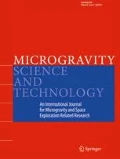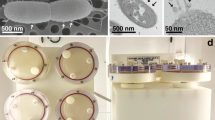Abstract
Cultures of Escherichia coli grown in space reached a 25% higher average final cell population than those in comparably matched ground controls (p<0.05). However, both groups consumed the same quantity of glucose, which suggests that space flight not only stimulated bacterial growth as has been previously reported, but also resulted in a 25% more efficient utilization of the available nutrients. Supporting experiments performed in “simulated weightlessness” under clinorotation produced similar trends of increased growth and efficiency, but to a lesser extent in absolute values. These experiments resulted in increases of 12% and 9% in average final cell population (p<0.05), while the efficiency of substrate utilization improved by 6% and 9% relative to static controls (p=0.12 and p<0.05, respectively). In contrast, hypergravity, produced by centrifugation, predictably resulted in the opposite effect — a decrease of 33% to 40% in final cell numbers with corresponding 29% to 40% lower net growth efficiencies (p<0.01). Collectively, these findings support the hypothesis that the increased bacterial growth observed in weightlessness is a result of reduced extracellular mass transport that occurs in the absence of sedimentation and buoyancy-driven convection, which consequently also improves substrate utilization efficiency in suspended cultures.
Similar content being viewed by others
References
Bouloc, P., D’Ari, R.: Escherichia coli Metabolism in Space. J. Gen. Microbiol., vol. 137, p. 2839 (1991).
Gasset, G., Tixador, R., Eche, B., Lapchine, L., Moatti, N., Toorop, P., Woldringh, C.: Growth and Division of Escherichia coli under Microgravity Conditions. Res. Microbiol., vol. 145, p. 111 (1994).
Thévenet, D., D’Ari, R., Bouloc, P.: The SIGNAL Experiment in BIORACK: Escherichia coli in Microgravity. Biotech., vol. 47, p. 89 (1996).
Manko, V. G., Kordyum, V. A., Vorob’yev, L. V., Konshin, N. I., Nechitaylo, G. S.: Microbiology: Changes over Time in Proteus vulgaris Cultures Grown in the ROST-4M2 Device on the Salyut-7 Space Station. NASA Contractor Report 3922 (14), p. 70 (1987).
Mennigmann, H. D., Lange, M.: Growth and Differentiation of Bacillus subtilis under Microgravity Conditions. Naturwissenschaften, vol. 73, p. 415 (1986).
Klaus, D., Simske, S., Todd, P., Stodieck, L.: Investigation of Space Flight Effects on Escherichia coli and a Proposed Model of Underlying Physical Mechanisms. Microbiology, vol. 143, p. 449 (1997).
Brown, R. B.: Effects of Space Flight, Clinorotation, and Centrifugation on the Growth and Metabolism of Escherichia coli. PhD thesis, University of Colorado, Boulder (1999).
Ciferri, O., Tiboni, O., Pasquale, G. D., Orlandoni A. M., Marchesi M. L.: Effects of Microgravity on Genetic Recombination in Escherichia coli. Naturwissenschaften, vol. 73, p. 418 (1986).
Kordium, V. A., Mashinsky, A. L., Manko, V. G., Babski, V. G., Sytnik, K. M., Kordyum, E. L., Bochagova, O. P., Nefedov, Y. L., Kozharinov, V. I., Grechkov, G. M.: Growth and Cell Structure of Proteus vulgaris when Cultivated in Weightlessness in the Cytos Apparatus. Life Sci. Space Res., vol. 18, p. 213 (1980).
Mattoni, R. H. T.: Space-Flight Effects and Gamma Radiation Interaction on Growth and Induction of Lysogenic Bacteria. BioScience, vol. 18, p. 602 (1968).
Klaus, D. M., Todd, P., Schatz, A.: Functional weightlessness during clinorotation of cell suspensions. Adv. Space Res., vol. 21, p. 1315 (1998).
Lam, K. S., Mamber, S., Pack, E., Forenza, S., Fernandes, P., Klaus, D.: The Effects of Space Flight on the Production of Monorden by Humicola fucoatra WC5157 in Solid State Fermentation. Appl. Microbio. Biotechnol., vol. 49, p. 579 (1998).
Klaus, D. M.: Microgravity and its Implications for Fermentation Biotechnology. Trends in Biotech., vol. 16, p. 369 (1998).
Walther, I., Bechler, B., Müller, O., Hunzinger, E., Cogoli, A.: Cultivation of Saccharomyces cerevisiae in a Bioreactor in Microgravity, J. Biotech., vol. 47, p.113 (1996).
Montgomery, P. O. B., Cook, J. E., Reynolds, R. C., Paul, J. S., Hayflick, L., Stock, D., Schulz, W. W., Kimsey, S., Thirolf, R. G., Rogers, T., Cambell, D.: The Response of Single Human Cells to Zero Gravity. In Vitro, vol. 14, p. 165 (1978).
Yee, L., Blanch, H. W.: Recombinant Protein Expression in High Cell Density Fed-Batch Cultures of Escherichia coli. Biotechnology, vol. 10, p. 1550 (1992).
Robbins, J. W., Taylor, K. B.: Optimization of Escherichia coli Growth by Controlled Addition of Glucose. Biotechnol. Bioeng., vol. 34, p. 1289 (1989).
Gottschalk, G.: Bacterial Metabolism. Springer-Verlag, New York (1986).
Barford, J. P., Pamment N. B., Hall R. J.: Lag Phases and Transients. Microbial Population Dynamics, M. J. Bazin (ed.), CRC, Boca Raton (1982).
Vogel, D. H., Bonner, D. M.: Acetylornithinase of Escherichia coli: Partial Purification and some Properties. J. Biol. Chem., vol. 218, p. 97 (1956).
Pollard, J.: Theoretical Studies on Living Systems in the Absence of Mechanical Stress. J. Theoretical Biology, vol. 8, p. 113 (1965).
Tixador, R., Richoilley, G., Gasset, G., Templier, J., Bes, J. C., Moatti, N., Lapchine, L.: Study of Minimal Inhibitory Concentration of Antibiotics on Bacteria Cultivated in vitro in Space (Cytos 2 Experiment). Aviat. Space Environ. Med., vol. 56, p. 748 (1985).
Tixador, R., Gasset, G., Ench, B., Moatti, N., Lapchine, L., Woldringh, C., Toorop, P., Moatti, J. P., Delmotte, F., Tap, G.: Behavior of Bacteria and Antibiotics under Space Conditions. Aviat. Space Environ. Med., vol. 65, p. 551 (1994).
Author information
Authors and Affiliations
Rights and permissions
About this article
Cite this article
Brown, R.B., Klaus, D. & Todd, P. Effects of space flight, clinorotation, and centrifugation on the substrate utilization efficiency ofE. coli . Microgravity sci. Technol. 13, 24 (2002). https://doi.org/10.1007/BF02881678
Received:
Revised:
Accepted:
DOI: https://doi.org/10.1007/BF02881678




